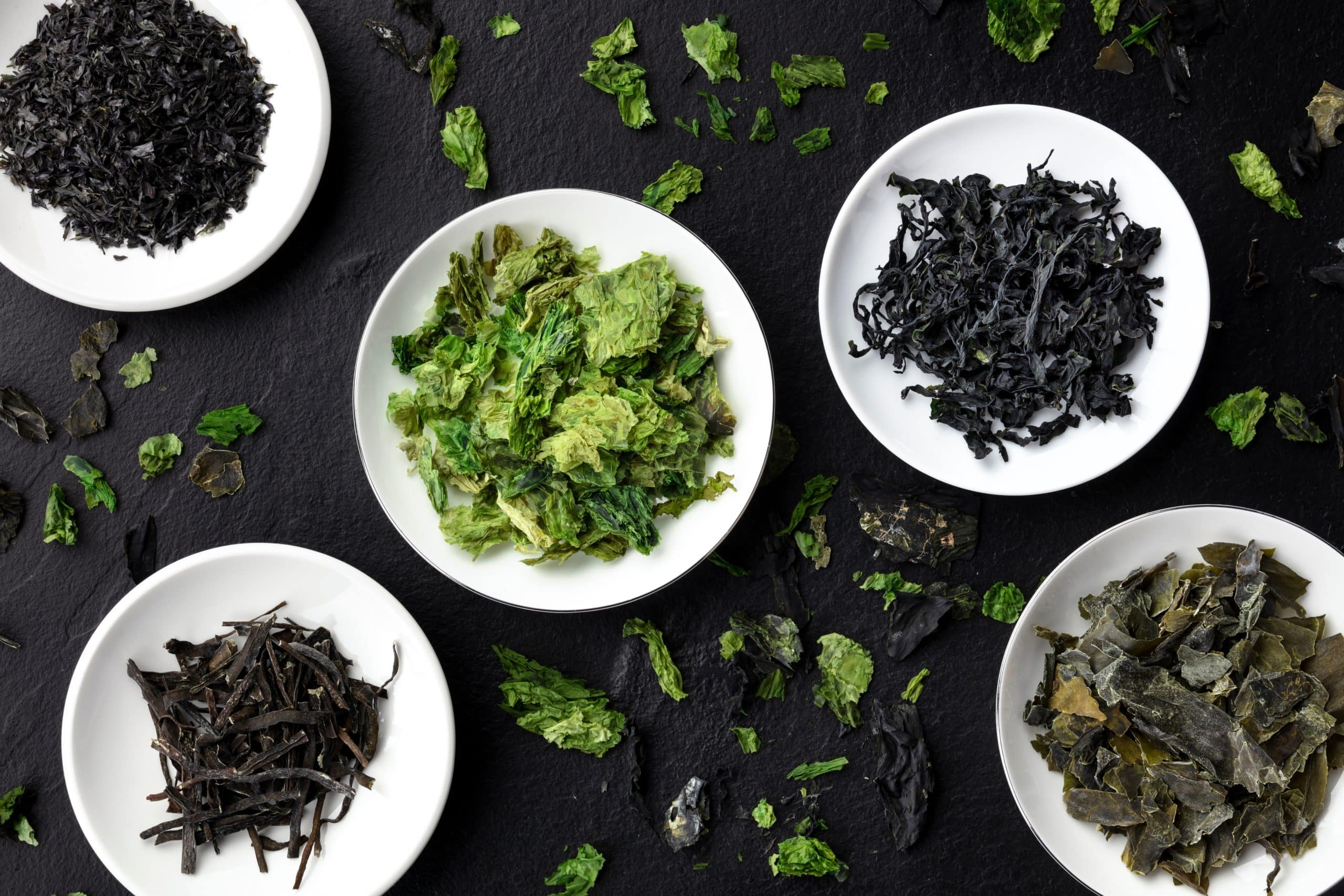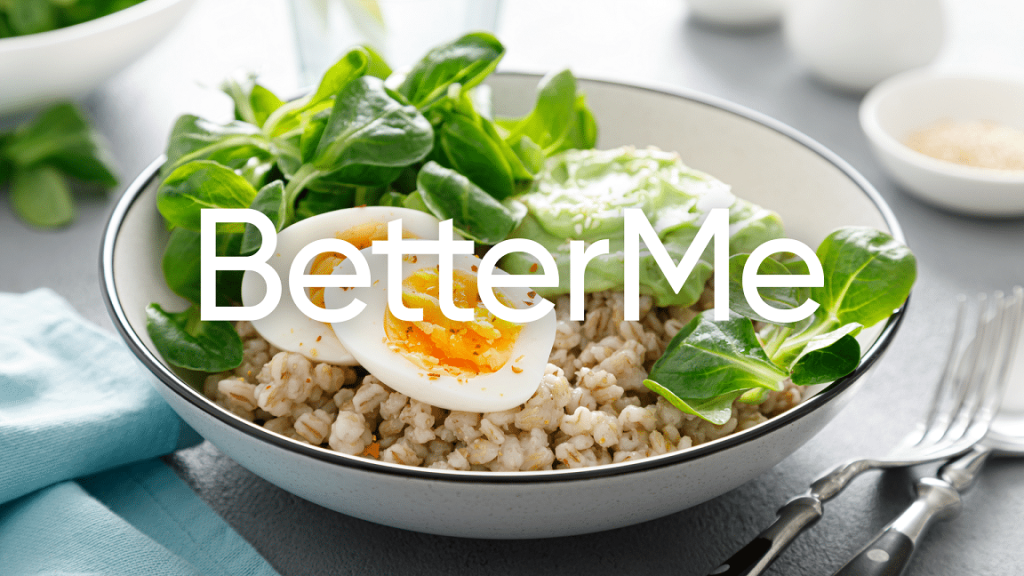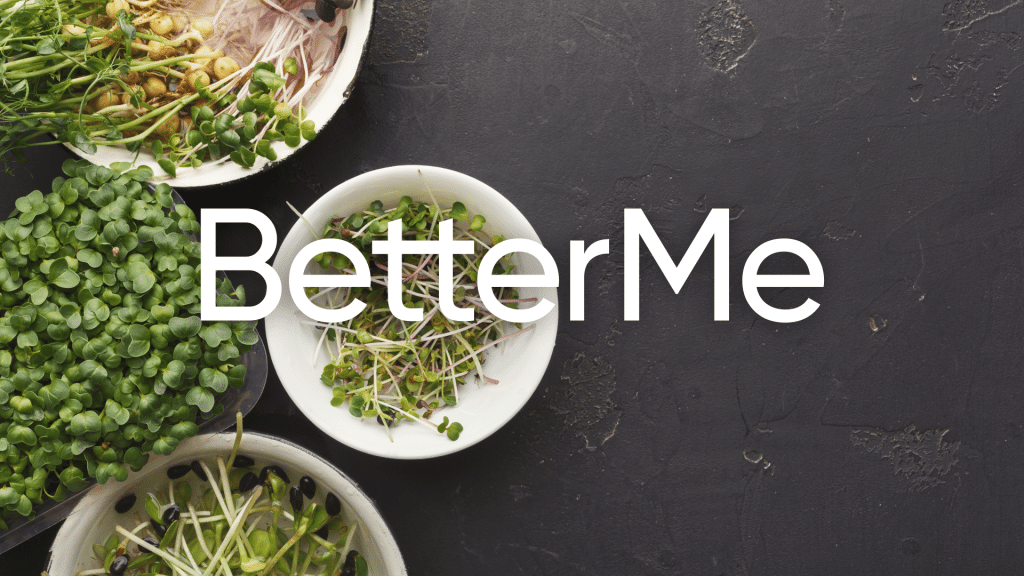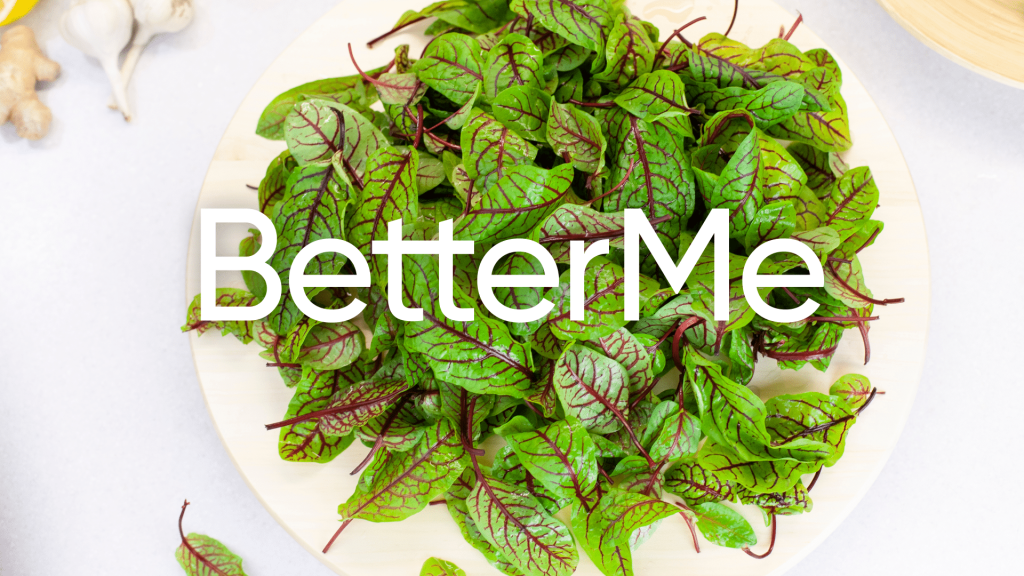Chinese, Japanese, and South Korean cuisine have long featured sea vegetables, also called seaweed. In the past few years, Westerners have started to embrace these strange-looking plants as well. You can now find them in everything from sushi to potato chips. Sea vegetables are a type of algae that grows in saltwater. Their nutritional profiles vary, but they’re generally a good source of fiber, vitamins, and minerals like iron and calcium (2).
Get your personalized
meal plan!
What Are Sea Vegetables?
Generally, seaweed refers to three main types of algae, as listed below:
- Brown seaweed: This type of seaweed includes kelp and nori. It’s rich in iodine, which is important for thyroid function. Brown seaweed also contains fiber, vitamins, and minerals.
- Red seaweed: This type includes dulse and Irish moss. It’s a good source of iron and magnesium. Red seaweed also contains carotenoids, which are antioxidants that may help protect against some chronic diseases.
- Green seaweed: This type includes spirulina and sea lettuce. It’s rich in chlorophyll, which is also an antioxidant with several suggested health benefits. Green seaweed also contains vitamins, minerals, and protein. of iodine, calcium, iron, and magnesium. It als
Sea Vegetables List
Below are some of the most popular and commonly consumed sea vegetables, along with their nutrient profiles.
Arame
Arame (Eisenia bicyclis) is a type of kelp that is common in Chinese, Japanese, and Korean cuisine. It has a mild, slightly sweet flavor and a soft, slippery texture. Arame is often used in soups, stews, and stir-fries.
Arame is a good source of iodine, calcium, iron, and magnesium. It also contains both soluble and insoluble fiber, as well as resistant starch.
Arame has been traditionally used for its purported health benefits. These include promoting digestion, reducing inflammation, and boosting the immune system (4). Arame is also said to be helpful in balancing hormones and preventing or treating goiter (an enlargement of the thyroid gland due to iodine deficiency).
However, there is currently no scientific evidence to support these claims.
Read More: How To Make Vegetables Taste Good? 8 Vegetable Ideas And Recipes
Aonori
Aonori, also known as green laver, is a type of edible seaweed. It’s often used as a condiment or seasoning in Japanese cuisine, and can be found in everything from soups and salads to noodle dishes and tempura.
Aonori is rich in minerals like iodine, iron, magnesium, and calcium, as well as vitamins A, B, and C. It’s also a good source of fiber.
Some research suggests that aonori and other seaweeds may have health benefits, such as aiding in weight loss, lowering blood pressure, and reducing the risk of cancer (5). However, more research is needed to confirm these potential effects.
Aonori is generally safe to consume, but some people may be allergic to it.
Badderlocks
Badderlocks (Alaria esculenta) is a type of edible seaweed. It’s sometimes called “dabberlocks” and is part of the kelp family. This particular variety of algae is found in cool, shallow waters along the coastlines of Europe and North America.
Badderlocks have a long, narrow, dark green or brownish-red frond that can reach up to two feet in length. It’s often used as a food or dietary supplement because of its high nutrient content, which includes vitamins, minerals, and antioxidants.
Traditionally, badderlocks have been eaten in Europe for centuries, and were even a staple food for some native North American tribes. Nowadays, you can find badderlocks sold dried, fresh, or frozen in many health food stores. It can be used in soups, stews, salads, or simply sautéed as a side dish.
Badderlocks is a good source of vitamins A and C, as well as iron, calcium, and magnesium. It also contains compounds such as fucoidan and alginate, which are linked to several possible health benefits.
Some of the potential benefits of eating badderlocks include aiding in weight loss, improving joint health, and reducing inflammation (5). While there are no specific studies on the health effects of badderlocks, the nutrients it contains are thought to contribute to these potential benefits.
For example, alginates can be considered a type of dietary fiber, which have been shown to slow the absorption of fat and sugar in the gut, which may help with weight loss. Additionally, fucoidan has anti-inflammatory properties which may help ease the symptoms of joint diseases like arthritis.
Dulse
Dulse (Palmaria palmata) is a type of red algae that is common in the northeastern Atlantic Ocean and the Irish Sea. It has a chewy texture and a slightly salty, umami flavor.
Dulse can be eaten raw, dried, or cooked. It is often used as a seasoning or condiment in soups, stews, and salads. Dulse can also be added to smoothies or juices for a nutritional boost.
Like arame, dulse is a good source of iodine, calcium, iron, and magnesium. It also contains both types of dietary fiber and resistant starch.
Dulse has been traditionally used to treat various digestive issues, including diarrhea, constipation, and indigestion. It is also said to support the immune system and reduce inflammation (7).
Betterme will keep you laser-focused on your weight loss journey! Nutrient-packed meal plans, fat-blasting workouts, galvanizing challenges and much more. Try using the app and see for yourself!
Nori
Nori (Porphyra umbilicalis) is a type of edible red algae that is common in the coastal waters of East Asia. It’s most commonly used in sushi rolls, but can also be eaten on its own or used as a wrapping for other dishes. It has a slightly salty, umami flavor.
Nori is an excellent source of iodine, which is important for thyroid health. It’s also a good source of protein, vitamins, and minerals.
Some people believe that nori has health benefits beyond its nutrient content, such as the ability to boost energy levels, improve digestion, and reduce inflammation (4). However, there is limited scientific evidence to support these claims.
Based on its nutrient content, it’s likely that nori does offer some health benefits. However, more research is needed to confirm its potential health effects.
Guso
Guso (Eucheuma seaweed) is a type of red algae that is farmed and harvested in the Philippines. It is used in various dishes, such as soups, salads, and sushi.
Guso is a good source of vitamins and minerals, including iodine, iron, magnesium, calcium, and potassium. It is also a source of dietary fiber.
Some people believe that guso has health benefits beyond its nutrient content, such as the ability to boost energy levels and reduce inflammation (7).
While guso does contain many nutrients that are essential to health, more research is needed to confirm its potential health effects.
Hijiki
Hijiki (Sargassum fusiforme) is a type of brown algae that is popular in Japanese cuisine. It has a long, thin, blackish-brown appearance and a slightly sweet, ocean-like flavor.
Hijiki is harvested from the wild and then dried and sold in packaged form. It can be found in many Asian markets and some health food stores.
Hijiki is a good source of dietary fiber, calcium, iron, and magnesium. It also contains small amounts of other minerals, such as manganese, potassium, and zinc.
The nutrients in hijiki may offer several health benefits, including improved digestion, stronger bones, and lower blood pressure (5).
Hijiki should be soaked in water for 20–30 minutes before cooking to rehydrate it. After soaking, hijiki can be cooked in a variety of ways. It can be stir-fried, simmered in soup, or added to other dishes like rice and noodles.
Hijiki has a strong ocean-like flavor, so it is often used in dishes with other seafood or seaweed ingredients. It can also be paired with vegetables, tofu, and meat.
While this sea vegetable is a good source of nutrients, it also can contain high levels of inorganic arsenic. Arsenic is a toxic element that can lead to adverse health effects (1). For this reason, it’s important to limit your intake of hijiki by varying your diet.immune system, relieve joint pain, and speed up
Read More: Ovo-Vegetarian Meal Plan And Diet Guide
Irish Moss
Irish moss (Chondrus crispus) is a type of red algae that grows along the rocky coasts of North America, Europe, and North Africa. Also known as carrageen moss or carrageenan moss, this sea vegetable is commonly used in Ireland and other European countries as a thickening agent in soups, sauces, puddings, and other foods.
Irish moss is rich in several nutrients that are important for health, including iodine, calcium, iron, magnesium, manganese, selenium, and zinc. It also contains carrageenan, a type of fiber that may have several health benefits (5).
Despite its nutrient content, there is little scientific evidence to support the use of Irish moss for any specific health condition. However, its nutrients make it a healthy addition to your diet.
It may help to support your immune system, relieve joint pain, and speed up wound healing.
Kombu
Kombu (Saccharina japonica) is a type of edible kelp, a large and diverse group of brown algae that grow in shallow, nutrient-rich saltwater.
It has a long, flat, ribbon-like shape and can grow up to 3 feet (1 meter) long. It’s usually black or dark brown in color and has a slightly chewy texture. Kombu is native to the cold waters off the coast of Japan, Korea, and China.
It’s been harvested and used in traditional East Asian cuisine for centuries. Today, kombu is widely available in dried form and can be found in most health food stores.
Kombu is often used in soup stocks and as a flavoring agent, but it can also be eaten on its own. This sea vegetable is a good source of iodine, iron, and other minerals. It’s also rich in vitamins and antioxidants (5).
While kombu is generally considered safe, there are a few potential side effects to be aware of which are related to excess iodine intake, such as thyroid problems. This is due to kombu’s high iodine content (3). As long as you eat seaweed in moderation as part of a varied diet, most healthy people don’t need to worry, but if you have a history of thyroid problems or other concerns, talk to your doctor about your seaweed intake.
Oarweed
Oarweed (Laminaria digitata) is a type of brown algae that is commonly found in the North Atlantic and North Pacific oceans. It can grow to be over 30 feet long and is often used as a food source in Japan and Korea.
Oarweed is a good source of several vitamins and minerals, including iodine, magnesium, and calcium. It is also a source of fiber and protein.
There are several potential health benefits said to be associated with oarweed consumption. These include: improved thyroid function, reduced inflammation, and enhanced blood sugar control. Additionally, oarweed is also said to help with wound healing (7).
While oarweed is a nutritious food, it is important to note that it can also contain high levels of mercury, as can other types of seaweed. As such, it should be consumed in moderation, particularly by pregnant women and young children.
BetterMe app will kick you out of the mental funk, shake off your extra weight, rid you off your energy-zapping habits, and help you sculpt the body of your dreams. Intrigued? Hurry up and change your life for the better!
Ogonori
Ogonori (Gracilaria) is a type of red algae that grows in the ocean. It’s common in Japanese and Chinese cuisine, and can be found in some health food stores in the United States.
Ogonori is a good source of vitamins and minerals, including iron, calcium, and magnesium. It’s also high in fiber and protein. It makes a great addition to soups, stews, and stir-fries.
Some people believe that ogonori has health benefits, such as lowering cholesterol and blood pressure, supporting the immune system, and helping with weight loss (7). However, there is no scientific evidence to support these claims.
Sea Grapes
Sea grapes, also called “green caviar” or “umeboshi,” are a type of edible seaweed. They’re usually found in the wild and harvested for food.
Sea grapes are a good source of vitamins and minerals, including calcium, iron, magnesium, potassium, and zinc. They’re also a good source of fiber.
Due to their nutritional content, sea grapes are said to have various health benefits, such as promoting weight loss, improving digestion, and reducing inflammation, although they have not been specifically studied (7).
While sea grapes are generally considered safe to eat, some people may experience an allergic reaction to them. If you’re allergic to other types of seaweed, it’s likely that you’ll also be allergic to sea grapes. If you have a seafood allergy, you may also be at risk of an allergic reaction to sea grapes or other types of seaweed.
It’s also important to note that sea grapes may contain high levels of cadmium, a toxic metal. This is especially true of wild-caught sea grapes. While cadmium exposure is a concern, it’s not thought to be a major health risk unless you consume large amounts of sea grapes on a regular basis. If you have concerns, discuss them with your doctor.
Sea Lettuce
Sea lettuce ( Ulva lactuca) is a type of edible seaweed that belongs to the green algae family. It’s one of the most common types of seaweed found in coastal waters around the world, and it’s often used in Asian cuisine.
Sea lettuce has a slightly salty taste and a crunchy texture. It’s often used as a wrap or as a salad ingredient.
Despite its name, sea lettuce doesn’t actually look like lettuce. It’s usually green or dark green in color and is often found in sheets or clumps.
Sea lettuce is a good source of several vitamins and minerals, including iodine, iron, and magnesium. It’s also a good source of protein and fiber.
Due to its nutritional content, sea lettuce has been touted as a health food. Some people believe that it has a range of health benefits, including weight loss, improved digestion, and reduced inflammation (7).
Wakame
Wakame (Undaria pinnatifida) is a type of edible kelp that grows in the ocean. It has a long, dark green leaf with a white stem. Wakame is commonly used in soups and salads.
Wakame is a nutritious seaweed that is high in vitamins, minerals, and antioxidants. It is said to have numerous health benefits, including weight loss, improved heart health, and reduced inflammation.
However, some people are concerned about the potential side effects of wakame, such as thyroid problems and iodine toxicity. Additionally, wakame and some other seaweeds can contain inorganic arsenic, although typically at levels that are considered safe to eat in moderation as part of a varied diet (6).
Overall, wakame is a healthy food that can be enjoyed in moderation. To use it, rehydrate the seaweed in water for 10 minutes before adding it to soups, salads, or other dishes.
The Bottom Line
Sea vegetables are a nutritious and delicious addition to your diet. They’re a good source of vitamins, minerals, and antioxidants. Additionally, they may have a range of possible health benefits, including weight loss, improved heart health, and reduced inflammation.
While most people can safely eat sea vegetables, some people may be at risk of an allergic reaction. Additionally, some types of seaweed may contain mercury, cadmium, or arsenic.
Consulting with a healthcare professional before adding sea vegetables to your diet is advised. This is especially important if you’re pregnant or breastfeeding, have a seafood allergy, or have a history of thyroid problems.
DISCLAIMER:
This article is intended for general informational purposes only and does not serve to address individual circumstances. It is not a substitute for professional advice or help and should not be relied on for making any kind of decision-making. Any action taken as a direct or indirect result of the information in this article is entirely at your own risk and is your sole responsibility.
BetterMe, its content staff, and its medical advisors accept no responsibility for inaccuracies, errors, misstatements, inconsistencies, or omissions and specifically disclaim any liability, loss or risk, personal, professional or otherwise, which may be incurred as a consequence, directly or indirectly, of the use and/or application of any content.
You should always seek the advice of your physician or other qualified health provider with any questions you may have regarding a medical condition or your specific situation. Never disregard professional medical advice or delay seeking it because of BetterMe content. If you suspect or think you may have a medical emergency, call your doctor.
SOURCES:
- Arsenic (2018, who.int)
- Algae as nutritional and functional food sources: revisiting our understanding (2017, nih.gov)
- Consequences of excess iodine (2014, nih.gov)
- Emergence of Seaweed and Seaweed-Containing Foods in the UK: Focus on Labeling, Iodine Content, Toxicity and Nutrition (2015, nih.gov)
- Nutritional and digestive health benefits of seaweed (2011, nih.gov)
- Risks and benefits of consuming edible seaweeds (2019, nih.gov)
- Seaweeds as a Functional Ingredient for a Healthy Diet (2020, nih.gov)















